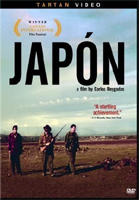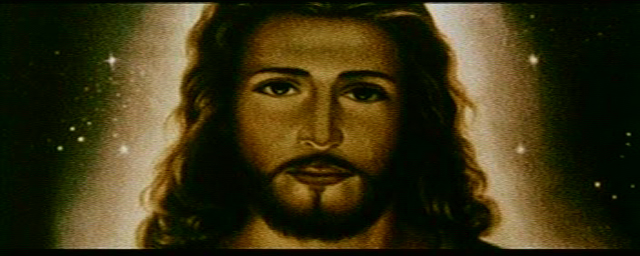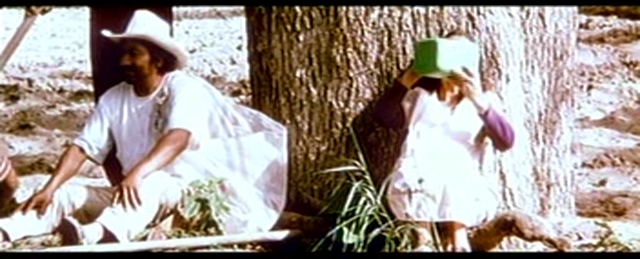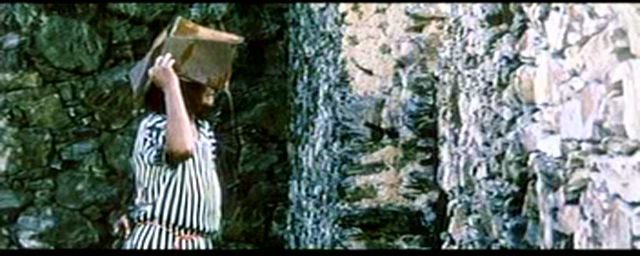
 BUY IT AT AMAZON: CLICK HERE!
BUY IT AT AMAZON: CLICK HERE!
STUDIO: Tartan Video
MSRP: $14.99
RATED: R
RUNNING TIME: 126 Minutes
SPECIAL FEATURES: Interview with dir. Carlos Reygadas
The Pitch
"2001
meets Koyaanisqatsi, with a bit of Harold and Maude thrown
in."
The Humans
Alejandro
Ferretis,
The Nutshell
It’s from
Tartan, and it’s called Japón, but don’t be fooled: this
isn’t a film from their Asian Extreme imprint. It’s a quietly-paced Mexican
tone piece about solitude and companionship. There are no child ghosts.
A man
(Ferretis) leaves behind the urbanity of
the wilderness to find a good place to die. In an isolated canyon, he finds a
village of simple people, and takes up lodging with an old widow (Flores). Dwarfed
by the landscape and made to feel utterly unimportant by his focus on death,
the man finds a balancing force in the indomitable faith, despite the fact that
the canyon and the world are so large as to not even bother to return an echo
at his loudest screams.

If you move around the room, his penetrating glare almost seems to follow you.
The Lowdown
The
screenplay for this thing must weigh in at somewhere around, oh, eight pages.
There is hardly any dialogue, and what little there is comes mostly in the form
of short, one-sentence tennis matches, lobs of a quick conversation. The
running time is dominated by an intense, Kubrick-style focus and patience on
the environment and on humans as a mutable feature of the setting.
There’s a
lot in the film that serves the purpose of detailing exactly how insignificant
people are when set against the backdrop of a massive world. In contrasting his
characters against the landscape of wilderness
transforms vistas that wouldn’t look bad on a postcard from beautiful to
heartbreaking — the mountains and forests are huge and uncaring.
In such
an open, silent world, people need to carve out spaces where they can feel as
if they are in control. When Ferretis’ character meets up with the old widow
Ascension, the audience is grateful for a retreat into a room with walls out of
a sympathetic desire for the man to reclaim some of his individual importance,
as we all like to do.
Ascension’s
hovel offers a religious contrast to the world beyond, as well, with every
available surface plugged with paintings of Jesus. The hut is her place, her
retreat, and where she can feel a spiritual closeness to whatever she chooses,
instead of being drowned out by sheer creation. The theory that we build houses
to give ourselves a sense of control isn’t an uncommon one in architecture, but
it does make for a brilliant stroke in the story Reygadas’ tells.

The world needs more bio-diesel.
What
little plot there is swirls around that tiny hut: there are men that claim they
own the land that Ascension is living on, and the nameless protagonist fights
them off. He forms a closer bond with Ascension and, when she makes the
metaphorical withdraw into her house, he begins to follow. The gradual
inward-turning is paced and developed beautifully and strikes exactly the tone
I imagine Reygadas was looking for in contrast to his transformation of nature.
A valley is beautiful to look at, but terrible to behold, in the context of the
film; whereas the relationship between Ascension and the man may be
unattractive to the eye, but has an alternately rough and tender beauty.
The
nameless man had set out to die. On his way down into the valley, he asks for
directions to someplace to stay. Despite the scale of wilderness, a farmer gives
him a simple path to follow and, speaking of the village, says, "You can’t
miss it." There is so much space to roam and get lost in, and yet you
can’t miss the presence of other people. Thank goodness for that.
The Package
I
received a screener that had none of the menus or bonus features (at least that
I could find, digging through the contents), but the case says there is a
theatrical trailer and an interview with director Carlos Reygadas, and I’d
really like to see the latter.
The video
quality is raw, and grainy, but intentionally so. Reygadas’ eye for beauty, and
talent for transforming it into something completely other, is supported by the
film technique. The audio is similarly rough around the edges and heightened so
as to submerge the viewer in a world of chirping cicadas, muttering villagers,
and wind.

"My hat, it has three corners…"
7.9 out of 10